A consortium approach of different partners can revolutionize dairy sector in India through promoting scientific dairy development activities and resource use efficiency. In this Good Practice Note, Drs. Prakashkumar Rathod, Sreenath Dixit, Kaushal Garg and Raviraj Jadhav share their experiences of improving the livelihood of farmers through multiple technical interventions in dairying under the ICRISAT- Government of Uttar Pradesh Project on Doubling Farmers Income in Bundelkhand Region of Uttar Pradesh, India.
CONTEXT
Dairying in Bundelkhand region continues to play a central role in providing livelihood security and coping mechanism to mitigate risks of resource-poor farmers. However, this key sector has not progressed to the desired extent in comparison to other regions of Uttar Pradesh and also across other states of India (Inter-Ministerial Team Report, 2008). Dairy development in this region is constrained due to several factors, namely: presence of low yielding non-descript cattle, low milk yield, less breedable population, scarcity of water, lack of green fodder, dominance of middle men in marketing, poor scientific knowledge etc. (Rathod and Dixit 2020). Apart from the above mentioned problems, Anna Pratha has been a worrying socio-economic issue in Bundelkhand region of Uttar Pradesh.
ANNA PRATHA: A SOCIO-ECONOMIC ISSUE
Free grazing or Anna Pratha (also called chhooth pratha), is an age-old tradition in Bundelkhand where farmers let their cattle loose, especially unproductive and pregnant cows and male cattle to freely graze after the rabi crop is harvested. Since the average landholding size is highest (1.49 ha) in Bundelkhand region as compared to other parts of U.P (Pandey and Reddy (2012), farmers therefore might satisfy themselves even with one good crop i.e. mostly in rabi season using residual moisture. From April onwards, thousands of animals are left to graze till September or October, before the onset of the sowing for next rabi crop. In kharif season, the roaming cattle destroy almost 25-35% of the agriculture produce (NITI Aayog-UNDP Report, 2012). All these scenarios lead to mono-cropping pattern in Bundelkhand region.
Most of the animals remain underfed and often move too far away from their homes and sometimes die. The farmers also express that they do not want to see the pain and suffering of their livestock and hence, let them loose. On several occasions, these animals are beaten or kept fenced without feed and water. In addition, this practice adversely affects the breed improvement programmes as local bulls are free to graze in the open fields and impregnate cows that are also left free. The artificial insemination programme suffers as a result in Bundelkhand region. Rathod and Dixit (2020) have estimated annual loss of about Rs. 1,619 crores per year for this region due to issues like Anna Pratha, monocropping etc. Ultimately, this issue leads to several other losses in the form of livelihood security, nutrition security etc. for the farming communities in Bundelkhand region. The damage caused by the stray cattle including draught animals on rampage is yet to be estimated, as no data is available on the extent of damage.
Although various development based research and extension activities are delivered by multifarious agencies, viz., ICAR institutions, National Dairy Development Board, Krishi Vigyan Kendra (Farm Science Centre), State Agricultural and Veterinary Universities, State Department of Animal Husbandry, private agencies, Dairy Cooperatives and NGOs, the farmers still continue with the traditional livestock rearing practices leading to low productivity in the region. Further, due to lack of convergence among different agencies involved in dairy development, the scientific technologies and practices developed in research institutes do not reach end-users (Rathod and Chander, 2015). It has to be noted that without convergence of efforts of public, private and other agencies it is difficult to reach a large number of dairy farmers with new and improved knowledge of dairying (Dixit et. al., 2016). In this context, the ongoing project focused on consortium[1] approach for improving dairy productivity and resource use efficiency. In this good practice note, we discuss how we developed the consortia and the practices we promoted-both technology and extension related.
THE INITIATIVE
With the financial support of Government of Uttar Pradesh, ICRISAT has identified and created a consortium to undertake expertise-based interventions in 20 pilot villages of seven districts in Bundelkhand region of Uttar Pradesh. The experience shared is from villages where this project is being implemented by ICRISAT Development Centre from May-June 2017 till date. The study involved individual farmers, member farmers of different organizations, officers of State Dept. of AH&VS, State Dept. of Agriculture, BISLD and NGO partners.
Table 1. Consortium partners in dairy development and their role clarity
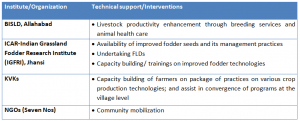
GOOD PRACTICES
Programme Design/ Methodology:
- In May 2017, with the help of district administration and officers of department of agriculture, the pilot sites covering about 5000 hectare area (hydrological boundary) in all the seven districts were identified. A cluster of two to three villages were selected for developing the pilot site in each district.
- A baseline survey of about 200 farmers from each district totalling 1,400 farmers from 20 selected project villages was carried out. The study included documenting status and issues in agriculture and animal husbandry practices faced by the farming community.
- Based on the baseline survey results, few issues like Anna Pratha, presence of low yielding dairy animals, poor access to veterinary and breeding services, lack of green fodder production etc. were identified as critical gaps in dairy sector of Bundelkhand region.
- To address these, competent institutions were identified and assigned the role of consortium partner in the project.
- Between May, 2017, and June, 2018, ICRISAT worked towards building rapport directly with the community with the help of local NGOs. Meanwhile, ICRISAT formed the consortium of national level institutions as depicted in Table 1.
- As experts in the animal husbandry sector, ICAR-IGFRI and BISLD also conducted a preliminary study dealing with dairy animal population, breedable population, types of animals reared, scope for SSS and EPD, fodder production status etc. in the project locations.
- Depending on the critical issues identified, multiple dairy development interventions like SSS, EPD, animal health and infertility camps, capacity building programmes, green fodder production etc. were initiated by the project partners
- A before-after research design was followed with participatory research to know the impact of these programmes in the project villages.
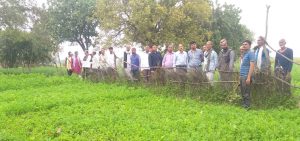 Field Day on Berseem fodder production for improving dairy productivity
Field Day on Berseem fodder production for improving dairy productivity
TECHNOLOGY RELATED PRACTICES
- Sex sorted semen (SSS) insemination at farmers’ doorstep: The farmers in these project locations face lack of timely veterinary and breeding services and often travel long distances to get these. SSS technology which is introduced in this project has a probability of giving birth to 90% female calves and hence, is revolutionizing Indian dairy sector by producing breeds of choice for the farming community. Initially, BISLD had a major focus on conventional insemination over the years but, in this project the major emphasis was given to SSS insemination and the funds were allocated for this activity through the project. As a part of this project, once the dairy animal was in estrus (heat), the farmers called the BISLD centre in-charge for undertaking SSS insemination. Depending on the history of the animal, the BISLD staff visited the animal and conducted SSS insemination. The major breeds preferred in the project locations are Sahiwal, Tharparkar and Jersey in cattle and Murrah breed in buffaloes. With high yielding animals, the farmers intend to reduce the herd size and thus, the pressure on food and fodder supply is reduced.
- This intervention was initiated in Mahoba and Chitrakoot districts of Bundelkhand, Uttar Pradesh from January, 2019. Although SSS is considered a costly affair in India, the farmers make a small payment while the majority of the cost is borne by the project team. Owing to very positive response from the farmers of two districts, ICRISAT and BISLD have initiated similar intervention in all the seven districts of Bundelkhand from October 2019, ultimately strengthening partnerships in the region. In this phase, the farmers were asked to pay very minimal amount since a new scaling-up project by BISLD was already initiated during this period with the funding from government of Uttar Pradesh.
- Early pregnancy diagnosis (EPD) at the farmers’ doorstep: As a part of this project, farmers are also being provided with rapid pregnancy diagnosis facilities, which makes possible pregnancy detection 18-19 days after SSS as against two-three months it normally takes, giving the farmer a strong reason to rear the animal. This involves milk test for detecting pregnancy based on hormonal content level in the milk. The farmers can make an early start in improving the care for their animals if they are pregnant or get them inseminated immediately in the next estrous cycle by BISLD staff. The cost of this intervention was borne by the project team to motivate farmers to adopt this technology.
- Animal health and infertility camps: BISLD in collaboration with ICRISAT and state Department of Animal Husbandry organized about 35 animal health cum infertility camps during last two years for the benefit of farmers. These camps have benefitted about 2,700 animals in the form of treatment for health issues, infertility, deworming, vaccination, mineral mixture distribution, etc. These camps have helped in reducing the number of infertile livestock in the project villages and also assisted in solving animal health related issues, leading to improving animal health and productivity in the project locations.
- Green fodder production: Apart from breeding and healthcare related activities, it was also realized that scientific feed and fodder production practices were very essential in improving the health and productivity of dairy animals. Since the farmers got breeding services for a breed of their choice, it was essential to maintain good health and improve the yield of such livestock. In this context, fodder production demonstrations were undertaken in the project locations. Through this intervention, the farmers were encouraged to cultivate legume and non-legumes fodder crops to fulfil the nutritional requirement of the livestock. The farmers are also motivated to cultivate more fodder and utilize it effectively in the upcoming season for improving health and productivity of livestock.
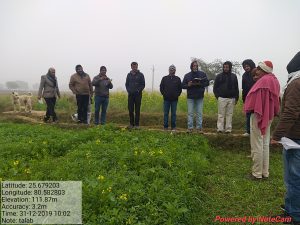 Experts from BHU, Varanasi, interact with farmer about Berseem fodder ©ICRISAT
Experts from BHU, Varanasi, interact with farmer about Berseem fodder ©ICRISAT
- Establishment of rural biogas plants: The project has realized multiple options for rearing livestock. Apart from SSS, EPD, health camps etc. five low-cost biogas plants (two in Chitrakoot and three in Mahoba) have been established in each village for domestic consumption. The farmers are provided with other accessories like biogas stove, pipeline connections, etc. These biogas units which are performing very well were established realizing the importance of dung and urine, which can be procured from farmers rearing two-three cows or buffaloes in the project villages. These units of 2 m3 capacity are sufficient for a household with four to six members and do not require a lot of space or nd skilled labour for construction, unlike earlier methods. These units can also be moved from one place to another. Consequently, with encouraging response from the farmers of two districts, ICRISAT and BISLD decided to establish a total of 20 more such biogas plants in all seven districts of Bundelkhand under DFI project at the earliest. These new models comprise a vermi-compost unit along with biogas plant at farmers’ place in each village that can have a significant socio-economic impact while ensuring well-being for the family, especially women.
Extension related Practices
- Mobile enabled information delivery: Mobile enabled information available with the BISLD staff is very beneficial for staff and the farmers. Once the SSS insemination is performed, the concerned details like farmer name, village, animal age, date of estrus, date of insemination, tentative date for EPD and other details are updated in the mobile software of BISLD staff. However, depending on the reminder facility available in this mobile, the services like EPD, date of repeat SSS if any, date of calving, etc. are monitored. The messaging service is also activated so that farmers are available with their animals at the time of visit by BISLD staff. This was planned to avoid confusion among farmers and BISLD field staff about the exact dates for undertaking different services. This also helps in recording real-time data of different services performed by the project staff and can be submitted to higher officials at any given point of time.
- Farm literature and video: The farm literature and reading materials about improved dairy farming practices in general, and breeding through SSS insemination were developed and distributed to the project beneficiaries. Further, several video clips were developed in vernacular language covering different experiences of farmers and field staff about breeding activities like SSS, EPD, infertility camps, etc.
- Formation of farmer interest groups: Local NGO partners along with project field staff have initiated formation of Farmer Interest Groups for the sustainability of project activities and create participatory involvement of beneficiaries. A few of groups aim to produce and sell fodder seeds, prepare supplementary feed, etc. but are still in infancy.
- Awareness programmes and capacity building: Multi-disciplinary teams conducted awareness and capacity building programmes on various topics related to scientific breeding, fodder production, feeding, healthcare, etc. for farmers and the project staff. The building of capacities of project staff on different topics at several occasions helped in strengthening their knowledge and building confidence in technologies. Further, the project team created awareness about importance of SSS, EPD, green fodder production, etc. and their contribution to livelihood of farmers as compared to conventional insemination and pregnancy diagnosis. Further, during the process, the farmers realized the importance of multiple activities which most of them didn’t follow initially. More than 2,200 farmers have participated in different livestock related programmes organized in different project villages in the last two years. The beneficiaries also participated in focus group discussions on different practices and issues under the guidance of experts or project staff.
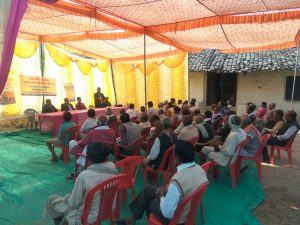 Awareness programme for farmers ©ICRISAT
Awareness programme for farmers ©ICRISAT
- Human resource for implementation and monitoring: The project involved technical staff from different partners for creating awareness and implementation of dairy development activities. With regards to breeding activities like SSS, EPD, etc. the farmers were being supported by BISLD centre in-charge for undertaking breeding related activities and was supervised by a district level BISLD official. Further, the project activities were also supported by field staff of ICRISAT, ICAR-CAFRI, ICAR-IGFRI, and local NGO partners. Apart from these field staff, the activities were also technically monitored by scientists and experts from different partnering institutions. Besides the project staff, state department officials from agriculture, animal husbandry and senior experts from BHU, Varanasi visited the project locations and offered their suggestions for improving project activities. The advisory services and follow-up in project locations on timely basis by the technical staff has proven highly beneficial.
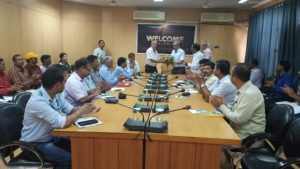 Review meeting and Evaluation by BHU team
Review meeting and Evaluation by BHU team
BENEFITS AND IMPACT
The outcomes or results of the interventions undertaken in the project locations require sufficient time to showcase benefits and impact. However, an effort has been made to compile such benefits and impact observed till date in the project locations.
Increase in birth of female calves: By the end of September, 2019, ICRISAT-BISLD reached the target of 310 inseminations. The birth of 87 females (53 buffaloes and 34 cows) and 04 male calves till the end of May, 2020, has been documented. About 95% female calf ratio has been a great achievement for the project and a great reason for farmers to rear livestock. Later, with a great response from the farmers of two districts (Mahoba and Chitrakoot), ICRISAT and BISLD have initiated these interventions in all the seven districts of Bundelkhand from October, 2019. By March 2020, about 460 new SSS AI were performed in which about 110 dairy animals were found pregnant. Interestingly, during this phase, BISLD embarked on a scaling-up project to conduct SSS in all their 174 centres in Bundelkhand region of Uttar Pradesh.
Cost effective early pregnancy diagnosis: Farmers in the project locations are being provided with early pregnancy determination facilities, which have 75-80% accuracy. Furthermore, the farmers have saved money which they normally spend on an animal considering it is pregnant for two-three months. The farmers also indicated that “money saved is money earned”. In the long term, early detection of pregnancy is expected to improve productive and reproductive performance of dairy animals.
| Box 1. Experience of Mrs. Malati Pateria
The first female calf through SSS technology was born at Nathupura village of Mahoba district on 1 November, 2019. The buffalo, aged about 9 years, gave birth to a Murrah calf in its third calving through Sorted Semen insemination. The landless farmer Mrs. Malati Pateria is happy with this female calf and stated that they could not believe that such a technology would bring lots of happiness in their lives. The family is dependent by performing labour and rearing two buffaloes for their livelihood. This family gets about 8-9 litres of milk per day which is sold to a local vendor at Rs 35/- per litre. The farmer gets the grasses and crop residues from other fields to feed these buffaloes. The farmer has also shared that good number of their neighbours and villagers visited the house to see the mother and calf from the day it was born. The happy farmer has decided to rear this calf by following all scientific practices and has expressed great faith in the DFI project’s interventions. The farmer also perceived that population of unproductive non-descript cattle may be reduced over a period of time using this technology. |
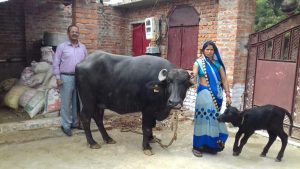 Mrs. Malati Pateria and Mr. A.K. Tripathi, Official of BISLD with buffalo and first female calf © BISLD
Mrs. Malati Pateria and Mr. A.K. Tripathi, Official of BISLD with buffalo and first female calf © BISLD
Improved green fodder production: Although green fodder cultivation was not a practice in Bundelkhand region, this project recorded about 1,130 farmers who have grown green fodder in about 225 acres of land during 2019-20. Interestingly, few farmers also sold berseem fodder at Rs 5/- per kg in markets. Majority of these farmers were also interested to produce their own fodder seeds for the upcoming season realizing its importance in improving health and productivity of livestock. The farmers with good quantity of green fodder were also show how preparation of silage to feed animals during lean season.
Increase in milk production and improved economic returns: Field level observations have confirmed that problems of less milk yield and low fat and solids not fat (SNF) content was solved to a great extent due by feeding green fodder crops to dairy animals. Farmers reported an increase of about 1-3 litres of milk per day after feeding green fodder. This increase in milk yield is fetching higher income for dairy farmers. The farmers also have varying range of income benefits depending on the quantity of green fodder utilized for their livestock. Furthermore, the farmers have saved money which they normally spend for purchasing fodder from other sources. Simultaneously, the farmers are getting calves of good breeds like Sahiwal, Tharaparkar and Murrah. The milk production performance of these calves would be recorded in the future.
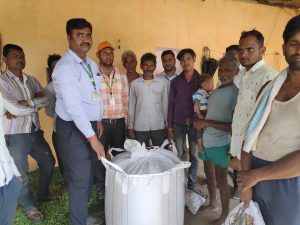 Scientists of ICAR-IGFRI, Jhansi demonstrate silage production to the farmers ©ICAR-IGFRI
Scientists of ICAR-IGFRI, Jhansi demonstrate silage production to the farmers ©ICAR-IGFRI
Utilization of animal wastes through rural biogas plants: The biogas approach has enabled farmers to reduce dependence on external sources for meeting their energy needs and soil nutrient requirements. These five biogas units in project locations have saved costs on purchase of LPG from June, 2019, and yield about 40 kg of slurry which is used as manure. These units have reduced time women spend collecting firewood and have helped in maintaining health of women and the household by being non-polluting. This unit also involves negligible risk as compared to leakage from LPG cylinder and improves hygiene conditions through proper dung disposal.
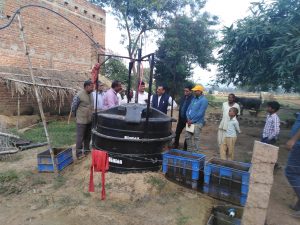 Officers of Agriculture department and project team interact with biogas farmer ©ICRISAT
Officers of Agriculture department and project team interact with biogas farmer ©ICRISAT
Improved knowledge level and interest of dairy farmers: Overall knowledge level of the beneficiaries about dairying in general, breeding through SSS, EPD, green fodder production, etc. and its importance has increased after participating in various awareness and capacity building programmes through the project. Further, the knowledge retention level has also improved due to project activities. Thought it was slightly difficult to convince farmers in the beginning about scientific practices, over a period of time the farmers have shown increasing interest in these practices after realizing their importance.
LESSONS LEARNT AND CHALLENGES FACED
As of now, the project has reached only a very small number of farmers. It is convincingly demonstrating how dairy development can be promoted in extremely difficult situations, ensuring that farmers and communities have timely access to breeding and veterinary services, fodder seeds and planting materials. There is an increase in income generation, ratio of female calf birth, quality and quantity of milk yield, area under fodder cultivation etc.
All this was possible due to integrated approach of consortium partners by sensitization, input delivery and improving knowledge levels of farmers. The concept of “seeing is believing” and “learning by doing” holds good in this case, since farmers experienced field level problems and found solutions in collaboration with multiple stakeholders. That said, there have been challenges during the process of implementation of the project that are depicted below.
- Project beneficiaries were not aware of the importance of scientific practices like SSS, EPD, green fodder production, etc. and hence, convincing farmers and creating awareness in the initial period was a challenging task for the project team. Nevertheless, the team made efforts to motivate the beneficiaries and strengthen their scientific knowledge.
- In case of fodder production, it was very difficult for the project team to explain the importance of agronomic practices and timely harvesting of green fodder. Although farmers were informed about the objective of fodder production, they harvested it for feeding their dairy animals as and when required. Hence, regular follow-up visits and field-level observations were essential.
- Environmental factors always play a major role in fodder production and its promotion. During the project period, both drought and heavy rain affected fodder production in project locations.
- The project in the initial phase faced problems of poor commitment from the farmers and the partnering institutions and their field staff. It was a difficult task for ICRISAT to identify the right partners and engage them to perform as per expectations of the funding agency. Further, managing more than 50 personnel, including scientists, was a tough task for ICRISAT in the initial period of time.
- During the implementation of the project, it was realized that water scarcity was the biggest challenge in project locations. However, the project teams also made several interventions like construction or renovation of water harvesting structures, field-bunding, etc. in collaboration with ICAR-CAFRI, Jhansi. Hence, it should be noted that all the project interventions are equally important in the process of sustainable dairy development.
- The farmers were asked to contribute some share (about 10 to 30%) while purchasing some inputs like fodder seeds, SSS etc. However, the farmers were very reluctant in the initial period. After realizing the quality of the inputs and the role of this project, there was competition among beneficiaries to procure inputs.
- On some occasions, the farmers could not tell BISLD staff from veterinary department staff and hence demanded BISLD staff to treat their livestock. However, the project teams had to satisfy the farmers by convincing the role and responsibilities of both organizations.
- In the initial phase of the project, few activities like distribution of mineral mixtures, performing deworming, etc. were undertaken by both ICAR-IGFRI and BISLD. However, over a period of time, the duplication of activities was avoided through effective communication among partners and the activities were then performed in a collaborative mode.
- The study has also realized that EPD and biogas plant establishment can be slightly costly for farmers. Hence, cost effective technologies to perform similar purposes may be developed by research organizations to improve the uptake of these technologies in the long run. If not, supporting the farmers in the form of some subsidy becomes a requirement to promote such technologies.
- Formation of Farmer Interest Groups and linking farmers to markets has been initiated very recently. This is the biggest challenge for the project teams due to various social and economic reasons. Hence, keeping in view the sustainability of the project, participatory involvement of beneficiaries and formation of interest groups is encouraged.
- Due to government regulations during COVID-19, the project activities have been hampered due to lack of follow-up, poor reporting and documentation, etc. However, recovering from such a scenario would be a big task for the project teams. Also, some strategy is essential to involve large number of villagers who have returned to their villages from different parts of the country during COVID-19.
WAY FORWARD
Though the project received poor response from the farmers initially, integrated extension approaches of consortium partners helped the project teams in improving knowledge levels and promotion of scientific technologies with very low investment. A policy shift emphasising delivery of inputs and regular follow-up for carrying out an integrated extension approach is very critical to enhance production and productivity.
In the existing scenario, we realize that the practice would be adopted easily if farmers get access to major inputs and services, knowledge about the practice, etc. Although farmers have gained adequate knowledge and developed a positive attitude towards dairy development, maintaining either formal or informal consortium approach among the partners is essential for a few more years in such development based projects. The project teams are emphasizing on formation of Farmer Interest Groups for sustainability of the project activities and to facilitate involvement of the beneficiaries. We believe that this type of a consortium approach is the way forward for large scale efforts to promote dairy development.
Acknowledgments
This study is a part of ICRISAT-Government of Uttar Pradesh Project on Doubling Farmers Income in Bundelkhand Region of Uttar Pradesh, India. The authors gratefully acknowledge the funds granted by Government of Uttar Pradesh and sincerely thank all the partners and respondents for their valuable inputs and suggestions.
References
Dixit VB, Tripathi H, Duhan A and Singh I. J. (2016) Convergence for Synergistic Effect in Dairy Development. AESA Blog-62. Available at http://aesa-gfras.net/Resources/file/Blog%2062.pdf
Inter-Ministerial Team Report (2008). Report on Drought mitigation strategy for Bundelkhand region of Uttar Pradesh and Madhya Pradesh by Inter-ministerial Team, pp.144.
NITI Aayog-UNDP Report (2012). Human Development Report, Bundelkhand-2012. Report prepared under NITI Aayog-UNDP Project on Human Development: towards Bridging Inequalities, pp.280.
Osterle H and Otto B (2010) Consortium Research: A Method for Researcher-Practitioner Collaboration in Design-Oriented IS Research. Business & Information Systems Engineering, 5: 283-293.
Pandey L and Reddy A. 2012. Farm productivity and rural poverty in Uttar Pradesh: A regional perspective. Agricultural Economics Research Review 25(1): 25–35.
Rathod PK and Chander M (2015). Are we generating need based and relevant livestock technologies? AESA Blog No-51. Available at http://aesa-gfras.net/admin/kcfinder/upload/files/BLOG%2051.pdf
Rathod P and Dixit S (2020) Dairying in Bundelkhand region of Uttar Pradesh: Constraints to realizing the potential. Indian Journal of Animal Sciences 90 (1): 3–11.
[1]A research consortium is a multilateral form of collaborative research in which practitioners grant researchers access to their knowledge, collaborate in the specification of solutions, test artefacts in their environments and finance research activities (Osterle and Otto 2010)
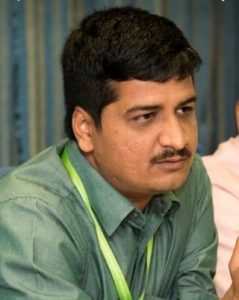 Dr. Prakashkumar Rathod is Assistant Professor in the Department of Veterinary & A.H Extension Education, Veterinary College, KVAFSU, Bidar (India). He was previously associated with ICRISAT Development Center, Research program-Asia, ICRISAT, Patancheru (India), during March 2018 to March 2020 (Email: prakashkumarkr@gmail.com).
Dr. Prakashkumar Rathod is Assistant Professor in the Department of Veterinary & A.H Extension Education, Veterinary College, KVAFSU, Bidar (India). He was previously associated with ICRISAT Development Center, Research program-Asia, ICRISAT, Patancheru (India), during March 2018 to March 2020 (Email: prakashkumarkr@gmail.com).
 Dr. Sreenath Dixit is Theme Leader and Head, ICRISAT Development Center, Research program-Asia, ICRISAT, Patancheru (India) (Email: D.Sreenath@cgiar.org)
Dr. Sreenath Dixit is Theme Leader and Head, ICRISAT Development Center, Research program-Asia, ICRISAT, Patancheru (India) (Email: D.Sreenath@cgiar.org)

Dr. Kaushal Garg is Senior Scientist, ICRISAT Development Center, Research program-Asia, ICRISAT, Patancheru (India). (Email: k.garg@cgiar.org)
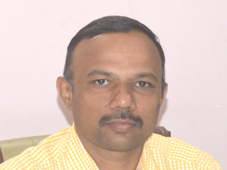
Dr. Raviraj Jadhav is Chief Programme Coordinator, BISLD, Allahabad, Uttar Pradesh.(Email: raviraj.jadhav@baif.org.in)


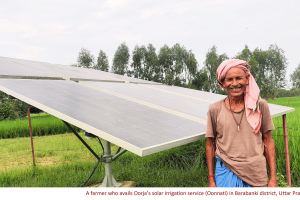
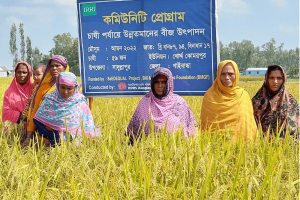
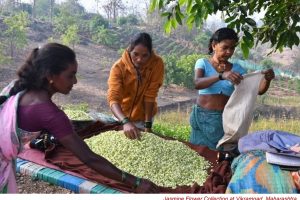
The blog addresses an important issue related to the dairy sector in India. Managing the stray cattle is a major issue faced by many cities. Lessons can be learned from these initiatives in tackling such issues sustainably.
The practices are very well written, could be followed in other states too. Congratulations